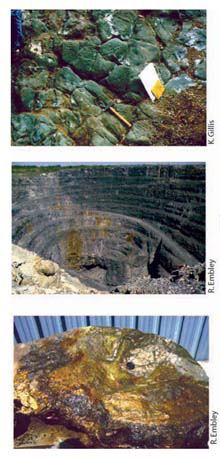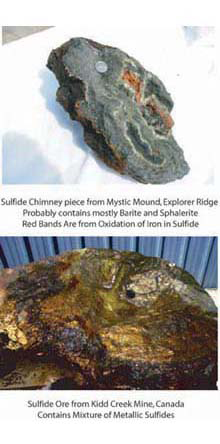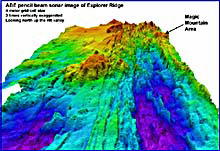
ABE Imagenex pencil-beam sonar image showing the crest of Southern Explorer Ridge and the location of Magic Mountain hydrothermal site. The image is gridded at 4 meter pixel cell size. Purple and dark blue colors indicate deepest depths. Note that the position of Magic Mountain is on the flank of the axial rift valley. Click image for larger view.
Submarine Ring of Fire - Summary of Year One at Explorer Ridge
June 28 - July 11, 2002
Bob Embley, Principal Investigator
NOAA, Pacific Marine Environmental Laboratory
We're heading into Victoria, British Columbia, after an extraordinary five weeks of exploration at the Explorer Ridge, a seafloor spreading center lying about 160 km (100 nautical miles) south of Vancouver Island. Before this expedition, the site had been largely unexplored. Using an array of new mapping and imaging tools, the seafloor has been brought to the surface here on the T. G. Thompson for examination, discussion and analysis. We have collected a prodigious amount of new information about the northeast Pacific Submarine Ring of Fire, and these data will be disseminated to the broader scientific community for collective analysis and discovery in the months and years ahead.
We started the exploration in late June, when the first profiles of the large hydrothermal plumes were made. Following the initial surveys with the CTD, which mapped out the plumes' locations, and the Thompson's EM300 multibeam sonar system, the autonomous vehicle ABE began a series of dives to collect high-resolution bathymetry, temperature, optical backscatter for detecting particle anomalies, seawater electrical anomalies, and magnetic field strength measurements.
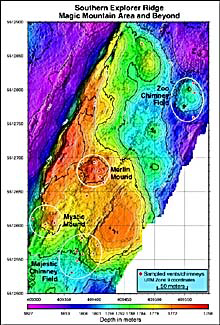
Bathymetric map of Magic Mountain area. Note the axial valley of Explorer Ridge in the upper left portion of the map. Vent fields are indicated by white circles. The red circles indicate some of the larger chimneys that were sampled on the Ocean Exploration expedition. Click image for larger view.
These results pinpointed the location of the major hydrothermal field, "Magic Mountain." A highlight of this part of the expedition was the extraordinary reliability of ABE in near-seafloor mapping, and the first-time use of a multibeam sonar on ABE. This provided maps of unprecedented detail for a deep ocean site. After a brief stop in Victoria, British Columbia, to pick up the ROPOS remotely operated vehicle and to change (most) of the scientific party, the T. G. Thompson spent a week at the NeMO observatory site on Axial Volcano. Then the Thompson headed back to Explorer Ridge with an interdisciplinary, multinational science party to explore the seafloor mapped during Leg I.
After the initial discovery of hot vents on Dive R665, ROPOS continued to find new vents at a prodigious pace. At least 30 active vents were found during the next eight dives, ranging in temperature from 20 C to 311 C. There was an extraordinary range of hydrothermal and associated biologic activity present at Magic Mountain area, ranging from young chimneys growing directly out of the pillow lavas (e.g., the Majestic area), to older chimneys sitting atop large sulfide mounds (Mystic and Merlin areas), to relatively isolated older chimneys with prolific biologic fauna.
The setting of Magic Mountain was a surprise. Unlike most hydrothermal systems found in the Pacific, the Magic Mountain site is situated outside the primary rift valley. The source of the hydrothermal fluid that "fuels" the Magic Mountain vents probably rises along the fault systems associated with a recent episode of rifting that, in turn, followed a massive outpouring of lava. Magic Mountain is a truly unusual hydrothermal site, with its off-axis location and relatively long-lived activity.
With further studies, the large sulfide mounds at Magic Mountain may also give insights into the processes of ore formation. Concentrations of iron, copper, zinc and other metallic sulfides within sequences of lavas deposited in ancient oceans have been mined for thousands of years. The increased demand for these metals in the industrial age led to more intensive prospecting and the discovery and exploitation of larger deposits from all over the world.
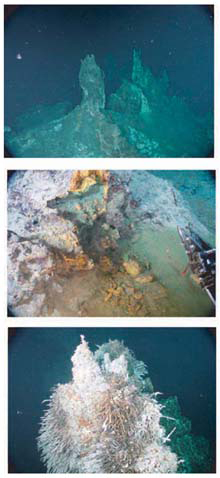
Examples of hydrothermal chimneys and mounds in the Magic Mountain area. The photographs were taken with the ROPOS digital still camera. Top image: Active chimneys on ridgetop vent group. (Note absence of tubeworms.) Middle image: Sulfide mound, Magic Mountain. Bottom image: Vent with tubeworms, Magic Mountain hydrothermal site. Click image for larger view.
However, the origin of these “volcanogenic polymetallic sulfides”, as they are known in the minerals industry, was a mystery before discoveries made in 1979 on the East Pacific Rise. It was in that year that very hot, mineral-laden fluid was first seen gushing from the seafloor. Because the dissolved minerals precipitated rapidly as the 350ºC fluid mixed with the cold seawater (at about 2ºC), the jet had the appearance of black smoke. Hence, the term “black smoker” was born. As word of the discovery spread, geologists studying ancient metal deposits quickly recognized that this phenomenon could explain the origin of many of these ores. In particular, there are sequences of volcanic rocks now exposed on land that are analogous to the modern mid-ocean ridge.
These sequences of rocks are called “ophiolites” and typically consist of layered sections of volcanic lavas, vertical dike intrusions (by which the lava flows are fed) overlain by deep, frozen magma of a type known as “gabbro.” In many cases, large bodies of polymetallic sulfides are found associated with the lava flow sequences. Some of these deposits relate directly to the development of the early technology. Supplies of early Bronze-age iron and copper came from ophiolites in Cyprus and other sites around the Mediterranean. However, it is unlikely that single smokers or even groups of smokers such as those found on the fast-spreading East Pacific Rise produce a large ore deposit because the lifetime for any given vent field at a fast-spreading rate is too short to form large deposits. The seafloor lying over the active axial magma source is too quickly rafted off to become part of the rapidly cooling plate. Volcanogenic ore deposits are large compared to most sites discovered on the mid-ocean ridge. The ores range between about 1 million tons of ore to more than 100 million tons in the largest deposits. Within a decade after the first discovery of smokers, much larger and long-lasting sulfide deposits were found at sites of slower spreading and at the other "end" of the plate, the island arcs. Magic Mountain probably doesn't have the longevity necessary to evolve into a massive ore deposit. However, because it is accessible, it may be an ideal site to carry out studies of how ores form in their early stages. In addition, very little is known about microbial activity in sulfide mounds, and Magic Mountain may be an excellent site for such studies because of its relative compact size and diversity.
The biologic discoveries at Magic Mountain have raised new questions. Why do the pycnogonids appear in such great numbers here? Why do the biologic communities only occur on certain chimneys? During the latter part of the Explorer Ridge explorations, intriguing relationships began to emerge between the biologic and geologic characteristics of the vents. For example, it was postulated that the fragile nature of many of the chimneys causes them to collapse under their own weight after a limited amount of growth, thereby limiting the colonization. The underlying reason for this is the relative lack of metals in the vent fluids emanating from Magic Mountain.
The process of exploration of the Explorer Ridge site may have opened up a whole range of new studies to be carried out in the future. The site had not been visited for over 15 years, but the knowledge gained during this 2002 expedition will hopefully provide enough new information to lead scientists to ask and answer some important new questions. We don't have all the answers, but we now have some interesting new questions, thanks to the opportunity afforded us by the NOAA Ocean Exploration Program.
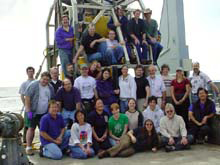
Explorers on Leg 2b of the Ocean Exploration Submarine Ring of Fire expedition. Click image for larger view.
The Sun Sets Over Explorer Ridge
Kimberly Williams
Teacher at Sea
We steamed away from Explorer Ridge with visions of the next leg of our journey over the horizon. This was a very productive expedition for the scientists on board, and everyone was excited that they had mapped out new and uncharted territory. The sights we saw and the knowledge we gained from the seafloor were something that I will never forget. But it wasn't just the seafloor that made an impression on me. I smile as I recall the many sleep-deprived conversations, and I enjoyed observing the interesting talents of the ROPOS crew that made me laugh until my sides hurt. I think about how much I learned out here that will make me a better teacher and a better person—all without lesson plans or lectures! This expedition really elevated my education far beyond both my teaching and my marine sciences degrees. I also realized on this cruise that I never want to live far from salt water, big open skies, and other people who have such a love to learn. As much fun as it has been writing for this Web site, it has been entertaining tenfold to hear anecdotes about the lives of the people I have worked with on this ship. They have demonstrated kindness, tolerance and teamwork that would make all of our representative nations proud. Calm seas and fair weather to you and thanks for keeping up with our deep-sea adventures!
Sign up for the Ocean Explorer E-mail Update List.























